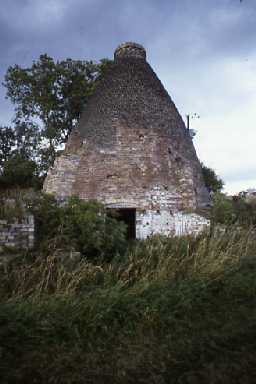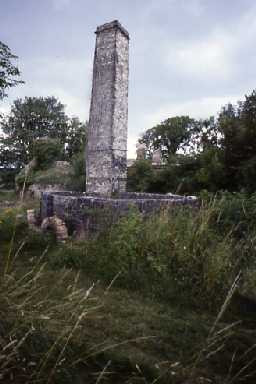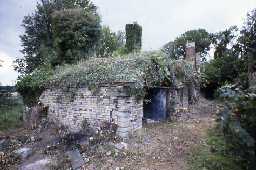Corbridge Pottery (Corbridge)
NY 992652. Two bottle kilns, part of Corbridge Old Pottery, a fireclay works, have been restored and leased by the Tyne and Wear Industrial Monuments Trust. (1)
Scheduled. (2)
Corbridge Pottery, established c.1840. Comprise two early 19th century 'bottle ovens'. Also a pair of 'Newcastle' horizontal kilns. The pottery closed c.1910. (3)
Fire clay salt-glaze ware works. Manufactured sanitary ware, firebrick, retorts, quarls, ridge tiles and chimney pots, etc. Probably disused since c.1900. The shells of two bottle kilns survive and one circular down-draught kiln and the site of another. Also four Newcastle kilns and associated mill buildings, drying flats, etc. Wheel pit of pugmill.
Known as Corbridge Fire Brick and Sanitary Tube Works, owned by Wylam Walker. The brick 'bottles' were enclosures for a kiln. (4)
Plan, five elevations and sectional elevation of some of the pottery buildings (1:100 scale) made in November 1977). (5)
Walker's Pottery operated from the early 19th century until about 1914, producing pipes, tiles and low-grade pottery for agricultural use, as well as bricks. One of the few remaining examples of a Tyne Valley rural pottery. (6)
Site specifically named as "Corbridge Pottery, Walker's Yard" in a general review of clay-based manufacturing sites in the North East of England (7); noted as operating 1855-1929, for much of the time under W Walker 1855-1906. Detailed desciption of the site made by 7; production of salt-glazed pottery items such as pipes, firebricks, fire fitings, fireclay items and the like, from two Newcastle-type kilns. Firecalays obtained from the drift mine nearby to the NE of the site held specifically by the pottery site. Surviving hovel kilns noted in 1986 review; the longest 53' x 12', made out of red common bricks. Series of kilns and drying sheds noted.
A desk-based assessment and level 3 analysis (English Heritage 2006) was carried out of the former pottery works, concentrating on the scheduled Bottle Kilns and the remains of buildings between them which are the subject of intended conservation and consolidation works to be grant-funded by English Heritage. The assessment also involved a review of historic and structural information for the whole complex and a statement of significance (Event 15598). The complex was also the subject of a photographic survey (Event 15599). (8)
The scheduling was revised on 8 December 2016 to include the standing, buried and earthwork remains of a post-medieval pottery originally known as Walker's Pottery. The remains include a cottage, two updraft or bottle kilns, part of a tramway, at least one circular downdraft kiln and chimney, two Newcastle horizontal kilns, drying rooms with under floor heating, a puddling pond, and one or more pugmills and stables with a walled yard. (9)
NY 993 652; NY 992 652. Kilns, Corbridge pottery. Scheduled No ND/575. (10)
[The bottle kilns are now recorded separately under HER numbers 15486 and 15487]
Scheduled. (2)
Corbridge Pottery, established c.1840. Comprise two early 19th century 'bottle ovens'. Also a pair of 'Newcastle' horizontal kilns. The pottery closed c.1910. (3)
Fire clay salt-glaze ware works. Manufactured sanitary ware, firebrick, retorts, quarls, ridge tiles and chimney pots, etc. Probably disused since c.1900. The shells of two bottle kilns survive and one circular down-draught kiln and the site of another. Also four Newcastle kilns and associated mill buildings, drying flats, etc. Wheel pit of pugmill.
Known as Corbridge Fire Brick and Sanitary Tube Works, owned by Wylam Walker. The brick 'bottles' were enclosures for a kiln. (4)
Plan, five elevations and sectional elevation of some of the pottery buildings (1:100 scale) made in November 1977). (5)
Walker's Pottery operated from the early 19th century until about 1914, producing pipes, tiles and low-grade pottery for agricultural use, as well as bricks. One of the few remaining examples of a Tyne Valley rural pottery. (6)
Site specifically named as "Corbridge Pottery, Walker's Yard" in a general review of clay-based manufacturing sites in the North East of England (7); noted as operating 1855-1929, for much of the time under W Walker 1855-1906. Detailed desciption of the site made by 7; production of salt-glazed pottery items such as pipes, firebricks, fire fitings, fireclay items and the like, from two Newcastle-type kilns. Firecalays obtained from the drift mine nearby to the NE of the site held specifically by the pottery site. Surviving hovel kilns noted in 1986 review; the longest 53' x 12', made out of red common bricks. Series of kilns and drying sheds noted.
A desk-based assessment and level 3 analysis (English Heritage 2006) was carried out of the former pottery works, concentrating on the scheduled Bottle Kilns and the remains of buildings between them which are the subject of intended conservation and consolidation works to be grant-funded by English Heritage. The assessment also involved a review of historic and structural information for the whole complex and a statement of significance (Event 15598). The complex was also the subject of a photographic survey (Event 15599). (8)
The scheduling was revised on 8 December 2016 to include the standing, buried and earthwork remains of a post-medieval pottery originally known as Walker's Pottery. The remains include a cottage, two updraft or bottle kilns, part of a tramway, at least one circular downdraft kiln and chimney, two Newcastle horizontal kilns, drying rooms with under floor heating, a puddling pond, and one or more pugmills and stables with a walled yard. (9)
NY 993 652; NY 992 652. Kilns, Corbridge pottery. Scheduled No ND/575. (10)
[The bottle kilns are now recorded separately under HER numbers 15486 and 15487]
N8673
PHOTOGRAPHIC RECORDING, Corbridge Old Pottery photographic survey 2015; Alan Williams Archaeology
DESK BASED ASSESSMENT, Corbridge Old Pottery 2015; Alan Williams Archaeology
DESK BASED ASSESSMENT, Corbridge Old Pottery 2015; Alan Williams Archaeology
Disclaimer -
Please note that this information has been compiled from a number of different sources. Durham County Council and Northumberland County Council can accept no responsibility for any inaccuracy contained therein. If you wish to use/copy any of the images, please ensure that you read the Copyright information provided.


